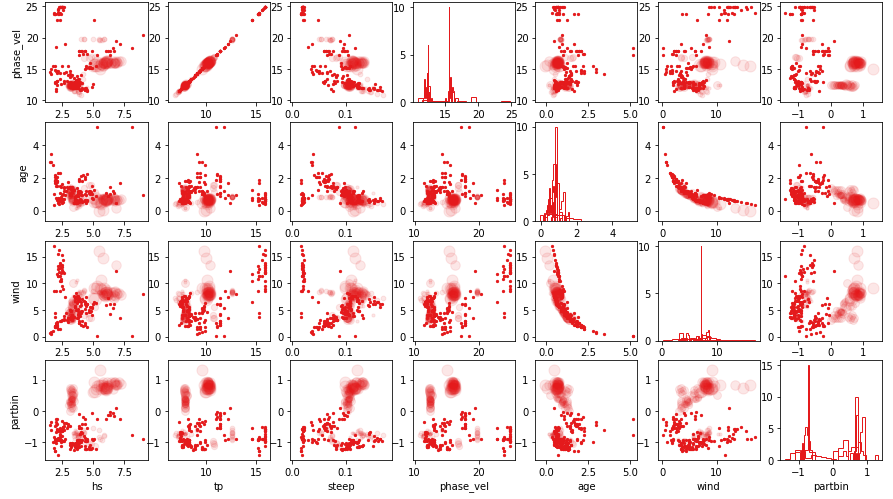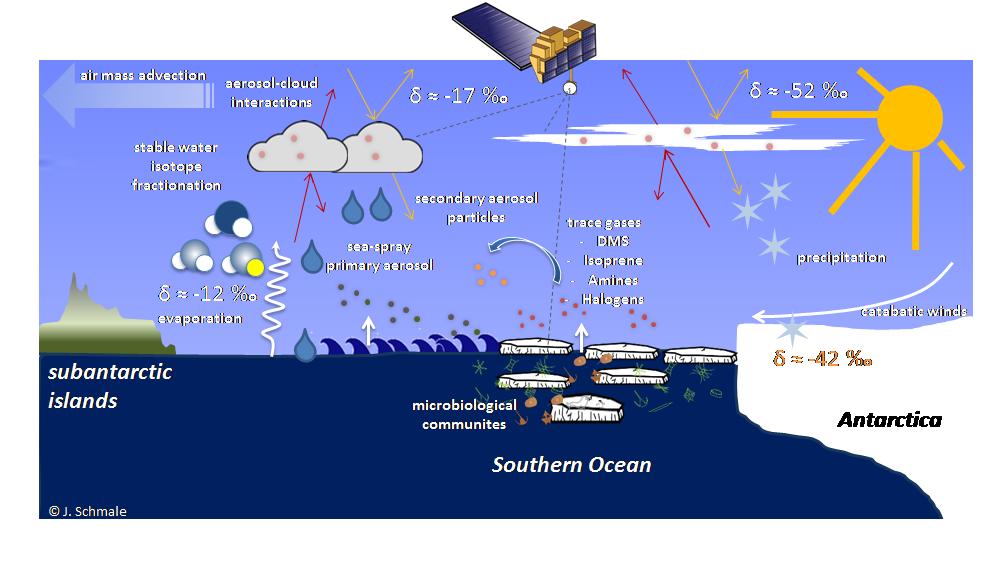
scatter plots of several variables recorded during ACE
Antarctic Circumnavigation expedition: Delivering Added value To Antarctica
Duration: December 2017 – March 2021
Publications
S. Landwehr et al. Exploring the coupled ocean and atmosphere system with a data science approach applied to observations from the Antarctic Circumnavigation Expedition, Earth System Dynamics, 10.5194/esd-12-1295-2021
S. Landwehr et al. Using global reanalysis data to quantify and correct airflow distortion bias in shipborne wind speed measurements, Atmospheric Measurement Techniques, https://doi.org/10.5194/amt-13-3487-2020
Scope of Project
The Antarctic Circumnavigation Expedition: Delivering Added value To Antarctica (ACE-DATA) project is a collaboration with the Swiss Data Science Center (SDSC) to create a data base for the measurements taken during ACE and to explore air-sea interactions by applying data science methods. The EERL is leading the latter part called Antarctic Sea-Atmosphere Interaction Data (ASAID) project.
The Antarctic Circumnavigation Expedition took place between December 2016 and March 2017 and conducted continuous measurements of physical, biological and chemical properties of the ocean and atmosphere. The Southern Ocean is the stormiest place on Earth, beaten by strong winds and waves that circle the Antarctic continent barely encountering geographical obstacles. This unique setting provides the region with a highly dynamic ocean, persistent cloud covers and rich ecosystems. The Southern Ocean influences the oceanic and atmospheric circulation as well as heat transport in the entire Southern Hemisphere and beyond. It is an important player in global carbon uptake and a regulator of current climate change. Climate models still perform very poorly in the Southern Ocean (IPCC, 2013) hinting at deficiencies in our general understanding of physical, chemical and microbiological air-sea exchanges, cloud formation and energy transport in the ocean and atmosphere. Given the remoteness of the Southern Ocean it is an obvious testbed for researching these natural interactions, however, to date in-situ measurements are scarce.
ASAID brings together a subset of the 22 ACE project that acquired data to explore air-sea exchange processes as depicted below.

Specific Research Questions
We are interested in understanding:
- How does the physical sea state invoke sea spray aerosol production and how much is sea spray contributing to cloud formation?
- Which regions of the ocean are particularly microbiologically active and how is this reflected in the chemical composition of aerosols and their ability to form cloud droplets?
- Can we relate signatures of weather patterns, microbiological activity, aerosol properties and sea state to identify a variety of processes that modulate air-sea exchange and its effect on the radiative balance over the Southern Ocean?
Expected Results
We expect to find out in how far the sea state, i.e. wave height, steepness and frequency, as well as the stability of the atmospheric boundary layer modulate sea spray production. We hypothesize that including sea state and atmospheric stability information in the modeling of sea spray production can significantly constrain the uncertainties in sea spray quantification over the Southern Ocean.
We also expect to identify “hot spot” area where marine microbial activity has a strong signature in the atmospheric composition and potentially on cloud formation. We further aim to find out how air-sea exchange is changing with sea surface temperature and hence latitude.
The combined results will enable us to improve global models to more accurately represent the biogeochemistry of the Southern Ocean.
Methodology
We apply two different approaches to exploring the data:
- To create an understanding of data density, variability and uncertainties, we use linear and non-linear statistical models to simulate specific observables (inductive approach). For example, we test in how far the addition of sea state variables to a model of sea spray production, which is traditionally relying on wind data only, will improve the predictability of sea spray generation.
- To combine more than 100 different air-sea exchange relevant variables, we apply a deductive approach, i.e. extracting patterns resulting from the application of a machine learning model and interpreting those a posteriori. Given the characteristics of the input data, we apply a sparse latent variable model.
Partners
ACE Project 1: Phytoplankton abundance and composition, David Antoine, Department of Physics and Astronomy, School of Science, Curtin University, Perth, Australia
ACE Project 7: Aerosol cloud interactions, Julia Schmale, EERL, EPFL and formerly: Laboratory of Atmospheric Chemistry, Paul Scherrer Institute, Villigen, Switzerland
ACE Project 8: Microbially-mediated air-sea interactions, Rafel Simó, Institut de Ciències del Mar-CSIC, Barcelona, Catalonia, Spain
ACE Project 11: Physical air-sea interactions, Heini Wernli, Institute for Atmospheric and Climate Science, Department of Environmental Systems Science, Federal Institute of Technology, Zurich, Switzerland
ACE Project 13: Phytoplankton as climate regulator, Nicolas Cassar, Division of Earth & Ocean Sciences, Nicholas School of the Environment, Duke University, Durham, USA
ACE Project 17: Air-sea interactions through waves, Alessandro Toffoli, Ocean Engineering, Oceanography, University of Melbourne, Melbourne, Australia

Funding
